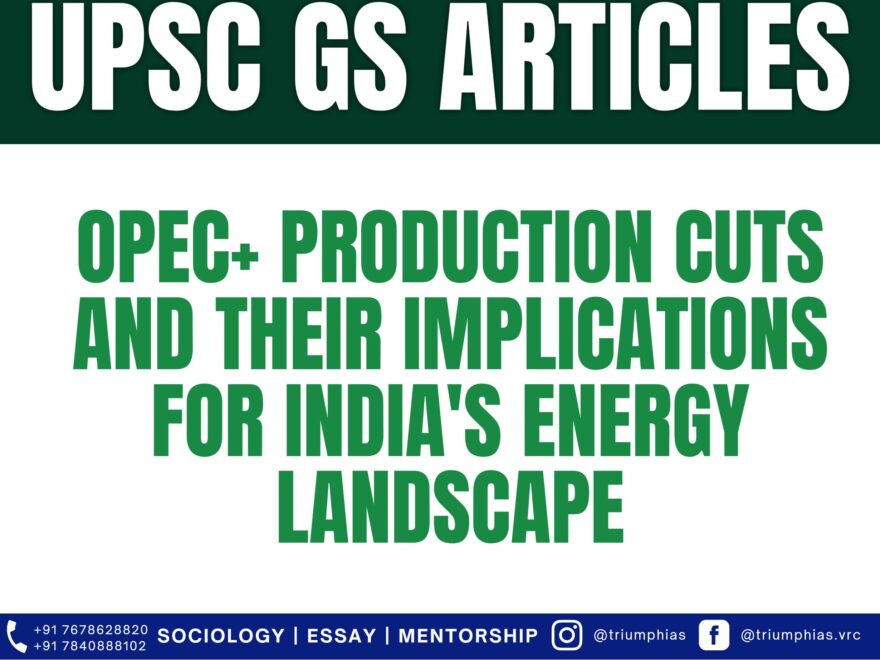Eye on oil: on oil prices and India
(Relevant for General Studies Prelims and Mains Examination)

The largest consortium of crude oil producers in the world, commonly known as OPEC+, has reached an agreement to extend ongoing production cuts until 2024. This decision aims to prevent a decline in oil prices amidst growing concerns about a global economic slowdown. Notably, Saudi Arabia, a prominent OPEC member and leading producer, has voluntarily committed to an additional reduction of 1 million barrels per day (bpd) in July 2023.
Comprising more than 20 nations, the OPEC+ alliance has been diligently working to limit oil supply in order to stabilize prices in the face of weakening demand. In a surprising move, they announced additional output cuts of 1.66 million bpd in April. However, for India, a country that heavily relies on imported crude oil, the combined announcements of supply reduction by Saudi Arabia and OPEC+ raise some concerns due to the potential impact on global oil prices. Nevertheless, India has significantly increased its crude oil purchases from Russia, resulting in a steady decline in the price paid for imported barrels of oil.
Reason behind OPEC+ Reducing Production
- China’s economic rebound following the Covid-19 lockdowns is losing steam, sparking concerns over its implications. As the world’s second-largest consumer of oil, this slowdown could have a significant impact on global oil demand and prices.
- Market dynamics have been disrupted by Western-imposed price caps on Russian oil, adding to the uncertainty. Recent apprehensions of another banking crisis have prompted investors to divest from riskier assets like commodities, including oil, leading to a decline in prices. Additionally, sluggish growth and reduced demand in developed nations, along with fears of a global recession, further contribute to the potential for lower oil prices.
- The ongoing US debt ceiling negotiations have also cast a shadow over the oil market. Investors worry that the outcome could adversely affect oil demand and result in price decreases, creating an atmosphere of market uncertainty.
- In a move to discourage speculators and short sellers betting on declining oil prices, planned production cuts will serve as a punishment. Saudi Arabia’s energy minister has issued a warning to traders against heavy speculation, which some investors perceive as a signal indicating potential output reductions.
- On the other hand, the United States is poised to increase its crude oil production through shale oil extraction and technological advancements, projecting a rise of 5.1% in 2023 and 1.3% in 2024. This growth in US output has significant implications for global oil supply and prices.
- Tensions with the US add to the complex landscape. The US is considering the passage of the NOPEC (No Oil Producing and Exporting Cartels Act), which would allow the seizure of OPEC’s assets on US territory if collusion in the market is proven. While the intention behind the act is to prevent price manipulation and foster fair competition, it has faced criticism due to concerns about potential retaliation from OPEC.
- OPEC+ has criticized the International Energy Agency (IEA) for what they perceive as politically motivated advocacy for oil stock releases last year, especially since the US is the IEA’s largest financial donor. The IEA argued that these releases were necessary to lower prices, but their predictions of price strength did not materialize. Furthermore, although the US initially indicated plans to repurchase oil in 2023, it later ruled out such a move.
- Maintaining the value of their primary export is crucial for OPEC, as observers of the group assert. In the face of inflation and currency devaluation, they need oil prices to remain high. The extensive money printing by Western nations in recent years has contributed to a decrease in the value of the US dollar, the currency in which oil is traded effect of this reduced production in India.
- India, ranked as the third-largest consumer of oil globally, relies on imports to fulfill over 80% of its total crude oil requirement. The majority of these imports, approximately 70%, come from OPEC members. While there has been a significant decrease in imports over the past decade, dropping from 87% to 70% in 2021-22, OPEC still holds a significant share in India’s oil imports. Therefore, the recent production cuts by OPEC+ will have adverse consequences for India, including the following potential effects:
- Escalating Imported Inflation: The reduction in production will drive up crude oil prices, amplifying India’s import bill and exacerbating the current account deficit by roughly 0.4% of GDP. This, in turn, will impact the retail prices of petrol and diesel, which are already soaring to record highs nationwide. The increased prices of these fuels will further trigger a surge in domestic commodity prices.
- Dampened Economic Growth: Higher oil prices will raise production and transportation costs across various sectors, impacting their profitability and competitiveness. Consequently, this will reduce consumers’ disposable income, leading to a decline in their demand for goods and services. The combination of elevated inflation and sluggish growth will pose a challenge for monetary policy.
- Heightened Fiscal Deficit: Mounting oil prices will escalate the subsidy burden on the government, which has to bridge the gap between the market price and the controlled price of kerosene and liquefied petroleum gas (LPG). As a result, the fiscal deficit will widen, constraining the government’s ability to allocate funds for infrastructure development and social welfare programs.
- Increased External Vulnerability: The surge in oil prices will augment India’s reliance on foreign exchange reserves and external borrowing to finance its oil imports. This heightened dependency exposes India to currency fluctuations and global financial shocks. Moreover, elevated oil prices will impact India’s trade balance and terms of trade with other nations.
What options does India has
- Revamp Energy Sources: India must prioritize the diversification of its energy mix by aggressively promoting and investing in alternative and renewable sources. Embracing solar, wind, hydro, and nuclear power on a large scale will enable India to reduce its reliance on fossil fuels and minimize its dependence on OPEC for oil imports.
- Boost Domestic Oil and Gas Production: India possesses substantial reserves of untapped oil and gas. The government should proactively incentivize both domestic and foreign oil companies to engage in exploration and production activities, both onshore and offshore. By implementing favorable policies, such as tax incentives and streamlined regulations, India can stimulate investment and bolster domestic production.
- Elevate Energy Efficiency: India must place energy efficiency at the forefront of its agenda across sectors such as transportation, industrial processes, and buildings. Embracing energy-efficient technologies, optimizing industrial processes, and implementing stringent energy conservation measures will pave the way for significant improvements in overall efficiency.
- Forge Strong International Partnerships: India should proactively forge strategic alliances with oil-producing countries outside of OPEC to secure alternative sources of oil. Strengthening relationships with nations like Russia, the United States, Canada, and others will offer opportunities for diversifying import sources and negotiating favorable supply agreements.
- Establish Strategic Oil Reserves: Maintaining robust strategic petroleum reserves is vital for India to act as a buffer during supply disruptions or price fluctuations. Expanding and fortifying strategic oil reserves will ensure a stable supply of oil during emergencies, thereby reducing vulnerability to OPEC’s decisions.
- Invest in Research and Development: India must channel significant resources into research and development (R&D) for advanced energy technologies. By focusing on breakthroughs in energy storage, electric vehicles, and other alternative fuels, India can accelerate its transition towards cleaner and sustainable energy sources, ultimately reducing its reliance on OPEC in the long term.
- Promote Public Transportation and Electric Vehicles: Encouraging the widespread adoption of public transportation systems and electric vehicles (EVs) will play a crucial role in curbing India’s oil consumption. Expanding the charging infrastructure and providing incentives for EV adoption will expedite the shift towards sustainable transportation options.
- Engage in Diplomatic Energy Efforts: India should proactively engage in energy diplomacy and actively participate in international forums to advocate for fair and stable oil markets. Collaborating with other oil-importing nations will empower India to influence OPEC’s decision-making and contribute to the creation of a more balanced and transparent global energy market.
To master these intricacies and fare well in the Sociology Optional Syllabus, aspiring sociologists might benefit from guidance by the Best Sociology Optional Teacher and participation in the Best Sociology Optional Coaching. These avenues provide comprehensive assistance, ensuring a solid understanding of sociology’s diverse methodologies and techniques.
Best Sociology Optional Teacher, Best Sociology Optional Coaching, Sociology Optional Syllabus, OPEC+, Crude Oil, Production Cuts, Oil Prices, India Oil Imports, Energy Policy, Renewable Energy, Economic Impact, Inflation, Fiscal Deficit, Energy Diversification, Energy Efficiency, Strategic Partnerships, Oil Reserves, Research and Development, Public Transportation, Electric Vehicles, Energy Diplomacy

